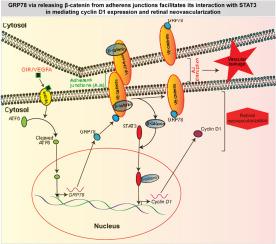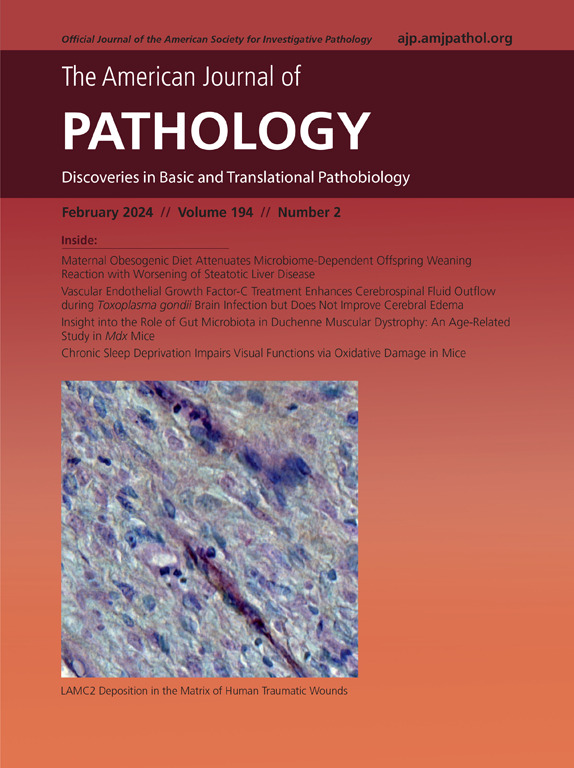Glucose-Regulated Protein 78, via Releasing β-Catenin from Adherens Junctions, Facilitates Its Interaction with STAT3 in Mediating Retinal Neovascularization
IF 4.7
2区 医学
Q1 PATHOLOGY
引用次数: 0
Abstract
Retinopathy due to neovascularization is one of the major causes of vision loss. To understand the mechanisms underlying retinal neovascularization the oxygen-induced retinopathy (OIR) model was used. Two-dimensional gel matrix-assisted laser desorption/ionization time-of-flight/time-of-flight analysis of normoxic and 24-hour post-OIR mice pups' retinas revealed that glucose-regulated protein 78 (GRP78) was one of the several molecules induced by OIR in the retinal endothelial cells (ECs). Vascular endothelial growth factor A (VEGFA) also induced GRP78 expression independent of endoplasmic reticulum stress response in human retinal microvascular endothelial cells, and its depletion reduced VEGFA-induced EC angiogenic responses. Consistent with these observations, EC-specific deletion of GRP78 inhibited OIR-induced retinal neovascularization. GRP78 bound with vascular endothelial–cadherin and released adherens junction, but not Wnt-mediated, β-catenin. β-catenin, in turn, via interacting with STAT3, triggered cyclin D1 expression. Furthermore, depletion of β-catenin or cyclin D1 levels negated VEGFA-induced EC angiogenic responses and OIR-induced retinal neovascularization. EC-specific deletion of GRP78 also suppressed OIR-induced vascular leakage. Studies of upstream signaling indicated that activating transcription factor 6 mediated GRP78 induction in the modulation of VEGFA-induced EC angiogenic responses and OIR-induced retinal neovascularization. Together, these observations revealed that GRP78, independent of its response to endoplasmic reticulum stress, is involved in mediating EC angiogenic responses by VEGFA and retinal neovascularization by OIR. In view of these findings, GRP78 emerges as a desirable target for drug development against diabetic retinopathy.

GRP78 通过释放粘连接头中的β-catenin,促进其与 STAT3 的相互作用,从而介导视网膜新生血管的形成。
新血管形成导致的视网膜病变是视力丧失的主要原因之一。为了了解视网膜新生血管形成的机制,我们利用氧诱导视网膜病变(OIR)模型,对正常缺氧和OIR后24小时的幼鼠视网膜进行了二维凝胶-MALDI-TOF/TOF分析。二维凝胶分析表明,GRP78 是 OIR 在视网膜 EC 中诱导的几种分子之一。在 HRMVECs 中,VEGFA 也会诱导 GRP78 的表达,而不依赖于 ER 应激反应,消耗 GRP78 的水平会降低 VEGFA 诱导的 EC 血管生成反应。与这些观察结果相一致的是,特异性地删除 EC 中的 GRP78 可抑制 OIR 诱导的视网膜新生血管。在探索其机制时,我们发现 GRP78 与 VE-cadherin 结合并释放粘连接头的β-catenin,而不是 Wnt 介导的β-catenin,β-catenin 反过来又通过与 STAT3 相互作用触发细胞周期蛋白 D1 的表达。此外,β-catenin或细胞周期蛋白D1水平的缺失会抑制VEGFA诱导的EC血管生成反应和OIR诱导的视网膜新生血管。细胞因子特异性缺失 GRP78 也抑制了 OIR 诱导的血管渗漏。在阐明上游信号传导时,我们发现 ATF6 在调节 VEGFA 诱导的 EC 血管生成反应和 OIR 诱导的视网膜新生血管的过程中介导了 GRP78 的诱导。总之,这些观察结果表明,GRP78 与其对 ER 应激的反应无关,参与了 VEGFA 对 EC 血管生成反应和 OIR 对视网膜新生血管生成的介导。鉴于这些发现,GRP78似乎可以成为糖尿病视网膜病变药物开发的理想靶点。
本文章由计算机程序翻译,如有差异,请以英文原文为准。
求助全文
约1分钟内获得全文
求助全文
来源期刊
CiteScore
11.40
自引率
0.00%
发文量
178
审稿时长
30 days
期刊介绍:
The American Journal of Pathology, official journal of the American Society for Investigative Pathology, published by Elsevier, Inc., seeks high-quality original research reports, reviews, and commentaries related to the molecular and cellular basis of disease. The editors will consider basic, translational, and clinical investigations that directly address mechanisms of pathogenesis or provide a foundation for future mechanistic inquiries. Examples of such foundational investigations include data mining, identification of biomarkers, molecular pathology, and discovery research. Foundational studies that incorporate deep learning and artificial intelligence are also welcome. High priority is given to studies of human disease and relevant experimental models using molecular, cellular, and organismal approaches.

 求助内容:
求助内容: 应助结果提醒方式:
应助结果提醒方式:


